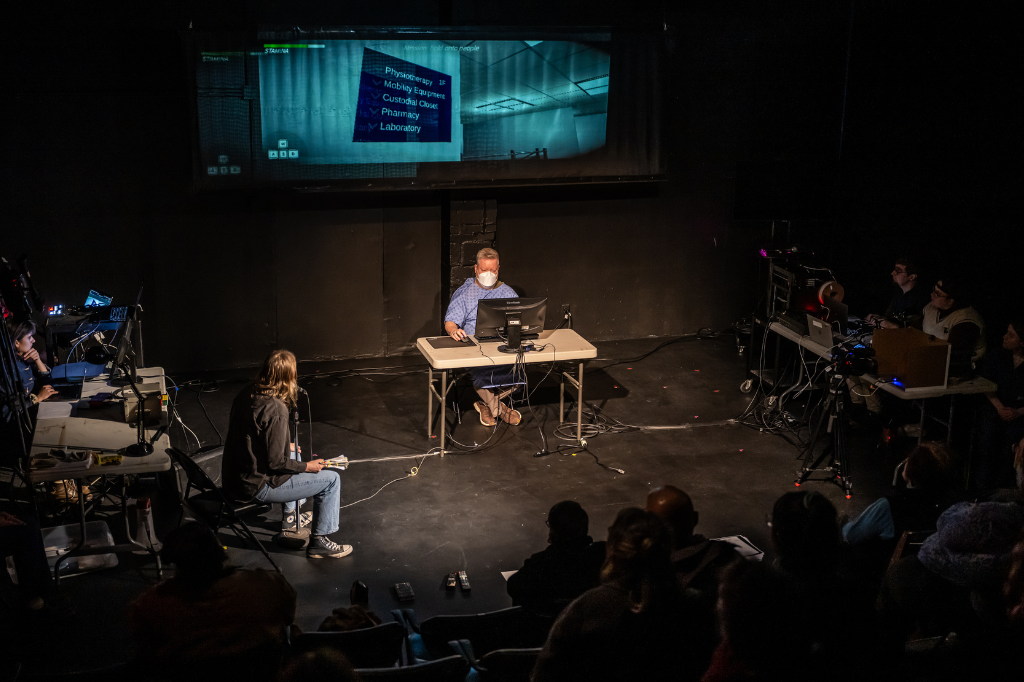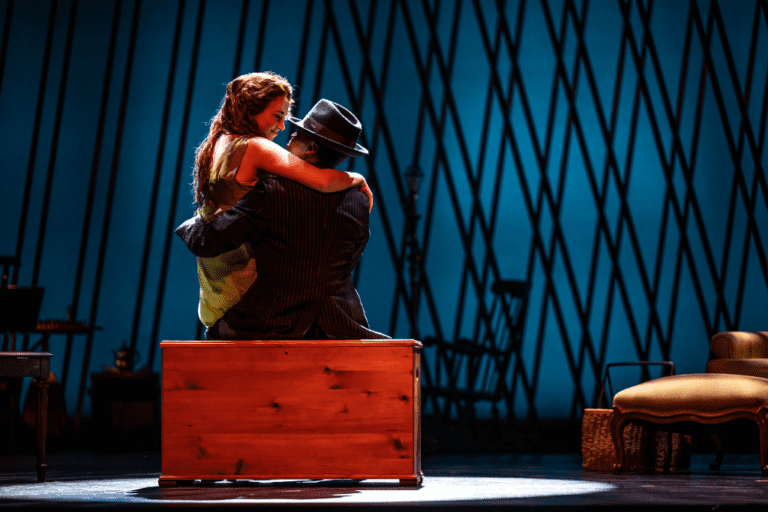The good and the bad (and everything in between)
Three years ago, Guilty by Association’s co-artistic directors, Cole Lewis (she/her) and Patrick Blenkarn (he/him) were texting each other while Cole’s terminally ill father was missing. A Silver Alert had been issued.
To lighten the gravity of the harrowing situation, they traded jokes about creating a future project around these events. The project would be called 2021, a response to 1991, their earlier live cinema work about a father-daughter road trip to America.
Patrick and Cole presented their newest project, 2021: Mechanisms to Hold, at Tarragon Theatre’s Greenhouse Festival earlier this month. In the following conversation, they reflect on the work’s themes of technology, narrative, and spirit.
Patrick Blenkarn (PB): Do you remember texting me about how your father had gone missing and joking we should make a sequel to 1991 about it?
Cole Lewis (CL): It’s funny, I always thought the idea of a sequel came from you. I remember feeling comforted by our exchanges that day. Which meant a lot to me, because my father was gone for over 14 hours. It was frightening. And being able to briefly laugh over texts with you meant a lot to me. It was comforting in a moment where I was very scared. But I always thought the idea for making a show about those events and that year came from you. I’m always surprised by how inaccurate memory can be. How fragmented it can be.
PB: We’re making a show, 2021, that explores how personal narratives take shape in a time when these narratives are fragmented and dispersed through a wide range of media — from analogue photography and objects to contemporary digital technology.
CL: Yeah, and also about how these media have a relationship to the idea of spirit.
PB: In our case, that spirit is your father’s, who was also a character in our earlier work, 1991, which premiered in 2019. How did we get here?
CL: In 2021, my dad lived in America and was dying of cancer. With COVID and the borders closed, I became a long-distance caregiver. And my caregiving was mostly mediated through technology: FaceTime, emails, Zoom, medical apps, insurance apps. It’s impossible to think about his death without that lens of mediation.
PB: Let’s talk more about that experience of mediation and technology. We live in a contemporary world of rapidly advancing forms of digital technology, some of which we engage with in the show, like natural language processing and video game technology. But we both also love older technologies.
CL: Yeah, you love books and I love photography.
PB: To put it lightly. You’re a bit of an obsessive collector of photography, aren’t you? Can you share a bit about your collecting practice, if we can call it that, and its influence on this project? I think it’s actually relevant to this project.
CL: I collect found photography, in particular daguerreotypes — early photographs from the mid-nineteenth century, produced on silver or silver-covered copper plates. When I see one, I have lots of questions: How can I accurately date it? What does the backdrop or clothing reveal? How can I separate what I am imagining about the photograph from what is a fact?
PB: In a sense, the opacity of the found photograph fosters a false proximity, or intimacy.
CL: I think so — if by opacity you mean that it’s difficult to know what’s happening in a daguerreotype. Not knowing the truth of a photograph invites a false sense of intimacy. When I look at a daguerreotype, my assumptions about the people, the places, immediately jump into my imagination. But so many of these imaginings say more about me and my biases than they do the actual subjects of the photo. When looking at a photo of somebody we don’t know, we’re always invited to imagine their life. And when we learn new facts about them, our imaginings can’t help but shift. The imaginings change.
PB: I’d argue that those “imaginings,” and the way one fills in the story based on fragmentary facts, are what we’re wrestling with in the show. We live in a time where a fragmentary or limited data set can be used to generate new variations following details or patterns from the set. I think 2021 is becoming more and more a reflection on how different technologies generate those variations.
CL: And as we say in the show, the way we used to project our imaginings onto photographs and traditional media, even video, isn’t enough for some people anymore. They want something more, more accurate, more alive, more responsive —
PB: — something that can capture as much about them as possible.
CL: Yeah. Which means the good and the bad, and everything in between.
If we’re not building a theatre that can hold the contradictions of our time, let alone the contradictions that make humans human, we probably shouldn’t be making theatre.
PB: As people who experience the show will see, your dad had those extremes — he was a human of contradictions. He was both, to quote you in the show, extremely generous and also an asshole.
CL: I loved my dad very much, but he wasn’t always an easy man. That, however, is a narrative I’ve constructed for myself. Maybe that narrative isn’t true.
PB: Another “imagining”?
CL: Maybe. I was speaking with my friend Shira Leuchter, who is also part of Tarragon’s Greenhouse Festival, about her work on The Haunting, which examines how we tell our ghost stories, the traces they leave on us, and the requests they make of us. It’s exploring uncannily similar questions. Shira once said to me (and gave me permission to quote her): “Thinking about memory or the past, all of that stuff is reconstructed to some extent. It’s corrupted. We’re creating narratives for ourselves.” I think we’re all trying to explore what she calls, the “blurry line between what is real and not real, between fiction and non-fiction.”
PB: I know that Shira means “corrupted” more as how we “alter memory,” but I like all the associations “corrupted” carries — the antithesis of purity. I think it is important to draw attention to the way a retelling of any story could be conceived as a corruption of a so-called original. If 2000 years ago an epic poet decided one night to spend a little more time elaborating on Penelope’s shitty situation in The Odyssey, did they corrupt the story? We’re considering corruption (corrupted data, corrupted stories) as a fundamental part of being alive and becoming dead.
CL: Yes! I think I’m both interested in trying to see if it’s possible for us to preserve my dad’s original spirit, but I’m also okay with drawing attention to how what remains might be altered or corrupted. And there’s an important tension in this interest. Because it means there’s very real dangers, along with potential harm, that we have to contend with as storytellers.
PB: But that’s our job. If we’re not building a theatre that can hold the contradictions of our time, let alone the contradictions that make humans human, we probably shouldn’t be making theatre.









Comments